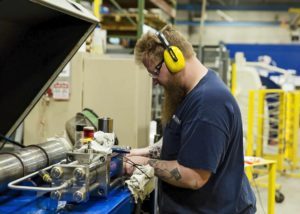
Hearing protection is an important part of industrial safety. Our workplace safety consultants have a number of helpful tips to determine the best ways to implement good hearing protection practices.
When Is Hearing Protection Required in the Workplace?
The importance of providing hearing protection is critical in many industrial workplaces. Hearing protection should be required when:
- Employees are exposed to workplace noise during an 8-hour work shift, in which the noise averages 85 dBA (50% dose) or greater;
- An employee has not yet had a baseline audiogram established (in a work environment) averaging 85 dBA or greater; or
- An employee has experienced a standard threshold shift.

The workplace noise level needs to be measured to determine the need for hearing protection. Type II noise meters are required by OSHA regulations to measure workplace noise and determine if a hearing conservation program is required. The occupational safety consultants at OECS use type II dosimeters to measure workplace noise over a work shift period versus spot checks with a meter. (Note: a “radio shack” type noise meter or a noise level meter phone app downloaded to your phone cannot be used to determine workplace noise levels for hearing conservation.) The dosimeter captures and averages all the noise an employee is exposed to within an 8-hour time period.
What’s the difference between decibel and dose?
A decibel dB(A) is a unit of measurement that indicates how loud a sound is. Dose, on the other hand, measures the accumulation of noise a person was exposed to. OSHA determines noise exposure based on dose, or the total amount of noise a person is exposed to during a defined period of time.

A good analogy is a river. A river is 200 feet across and flows at a rate of 10,000 gallons per minute. The water flow rate speed (water pressure) resembles how loud something is, similar to a decibel (air pressure). If you measure how much water has flowed in 10 minutes past a fixed point, the amount would be 100,000 gallons (10 minutes x 10,000 gallons). More time, more gallons. This total accumulation of water (10 minutes) is water “dose.” Total noise accumulation within a time period is noise dose. Water dose and noise dose are very much the same concepts.
The OSHA regulations’ dose equivalent to 85 dBA is 50%; at 90 dBA the dose is 100%. If the noise levels average is 85 dBA over an 8-hour work shift, the dose will be 50%. But what if a shift at your workplace is 10-12 hours? How does dose relate to a work shift that lasts longer than 8 hours and does it impact the importance of providing hearing protection equipment in the workplace?
The answer
You need to be careful when calculating how much dose a person receives when the work shift is 10-12 hours, since the noise exposure amount is greater and can adversely affect industrial safety. Suppose the average noise level is 83.4 dBA for each 10-12 hour shift — pretty steady. OSHA uses 50% dose which is equivalent to 85 dBA and based on an 8-hour shift. But dose changes when the shift is 10-12 hours, because you are exposed to more noise. Using the noise level 83.4 dBA, is a hearing conservation program needed? It is below 85 dBA.
Say a person works 10-12 hours per shift, where the noise exposure is 83.4 dBA (dose equivalent 40%). The initial thought might be, “Thank goodness the employee noise level is 83.4 dBA, which is below the 85 dBA limit! A hearing conservation program is not required.” However, after calculating the 10-12 hour shift and noise level, the new dose for the 10-hour shift is now 50%, which is 85 dBA, thus requiring a hearing conservation program. At 12 hours, the dose is 60%, which is equivalent to 86.3 dBA and certainly requires a hearing conservation program.
OECS helps with the importance of hearing protection in the workplace
 OECS workplace safety consultants can help you determine the amount of noise exposure at your Minnesota, Wisconsin, North Dakota or South Dakota-based company to see if a hearing conservation program or engineering controls are needed. We’re ready to help with industrial health and safety plans custom to your company. Contact us to request a safety audit or give us a call at 763-417-9599.
OECS workplace safety consultants can help you determine the amount of noise exposure at your Minnesota, Wisconsin, North Dakota or South Dakota-based company to see if a hearing conservation program or engineering controls are needed. We’re ready to help with industrial health and safety plans custom to your company. Contact us to request a safety audit or give us a call at 763-417-9599.
 763.417.9599
763.417.9599
